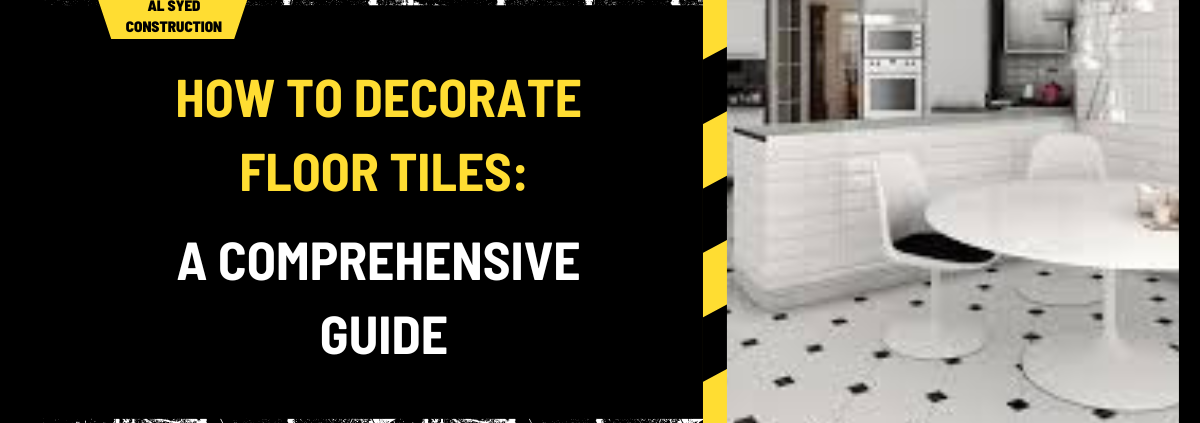How to Decorate Floor Tiles: A Comprehensive Guide
Decorating floor tiles can transform an ordinary space into an extraordinary one. Whether you are looking to refresh your living area, bathroom, or kitchen, the right approach to decorating tiles can enhance aesthetics, functionality, and overall ambiance. In this detailed guide, we will explore various methods and tips to help you achieve a stylish and cohesive look for your tiled floors.
Choosing the Right Floor Tiles
1. Selecting Tile Material
Tile material significantly impacts the appearance and durability of your floor. The most common options include:
- Ceramic Tiles: Affordable and versatile, ceramic tiles come in various colors and patterns.
- Porcelain Tiles: Known for their durability and low water absorption, ideal for high-traffic areas.
- Natural Stone Tiles: Including marble, granite, and slate, these tiles offer a luxurious look and unique patterns.
- Glass Tiles: Provide a sleek and modern appearance with reflective qualities.
2. Tile Size and Shape
The size and shape of the tiles play a crucial role in the overall design. Larger tiles can make a space look bigger, while smaller tiles can create intricate patterns. Consider the scale of your room and the visual effect you want to achieve.
Designing Tile Layouts
1. Traditional Patterns
Traditional patterns like the grid layout or diagonal layout are timeless choices. A grid layout features tiles arranged in straight rows, while a diagonal layout adds visual interest by placing tiles at an angle.
2. Herringbone and Chevron Patterns
Herringbone and chevron patterns involve arranging tiles in a V-shaped pattern. These designs add dynamic movement and are excellent for creating a focal point in a room.
3. Mosaic Patterns
Mosaic tiles can be used to create custom designs or feature walls. Mosaics are available in various materials and can be arranged in intricate patterns or simple designs.
4. Custom Borders and Insets
Adding borders or insets can define specific areas of a room. Use contrasting colors or materials to create a visual distinction and enhance the overall design.
Color and Finish Selection
1. Choosing Tile Colors
Tile color impacts the mood and style of the space. Light colors can make a room feel more spacious and airy, while darker colors add warmth and coziness. Consider complementary or contrasting colors to enhance the room’s décor.
2. Finishes and Textures
Tile finishes range from glossy to matte. Glossy finishes reflect light and can make a room appear brighter, while matte finishes offer a more subdued, contemporary look. Textured tiles can add depth and interest, but ensure they are suitable for floor use.
Incorporating Decorative Elements
1. Grout Color and Style
Grout color can dramatically affect the overall look. Choose a grout color that contrasts with or complements the tile. Grout styles, such as epoxy grout or sand-based grout, provide different benefits in terms of durability and ease of cleaning.
2. Tile Accents and Inserts
Add tile accents or inserts to create focal points or highlight certain areas. Accent tiles can include decorative patterns, colors, or textures that stand out against the main tile layout.
3. Rugs and Mats
Incorporating rugs or mats on top of floor tiles can introduce additional color, texture, and comfort. Ensure that the rugs are easily removable for cleaning and do not damage the tiles.
Installation Tips and Techniques
1. Proper Surface Preparation
Before decorating, ensure the subfloor is clean, dry, and level. Any imperfections can affect tile adhesion and the overall finish. Use a self-leveling compound if necessary to correct uneven areas.
2. Using a Tile Layout Plan
Create a tile layout plan to visualize how tiles will be arranged. This helps in making precise cuts and achieving a balanced design. Consider using tile spacers to maintain consistent grout lines.
3. Cutting and Fitting Tiles
When cutting tiles, use a tile cutter or wet saw for accurate results. For intricate cuts, a tile nipper or angle grinder may be required. Measure and cut tiles carefully to fit around edges and corners.
4. Grouting and Sealing
After tiling, allow the mortar to cure completely before applying grout. Use a grout float to fill joints and wipe off excess grout. After the grout has set, seal the grout lines to prevent staining and moisture infiltration.
Maintaining and Cleaning Tiled Floors
1. Regular Cleaning
To maintain the beauty of your tiles, clean regularly using a mild detergent and a soft mop. Avoid harsh chemicals that can damage the tile surface.
2. Addressing Stains and Damage
Promptly clean up spills and stains to prevent permanent damage. For stubborn stains, use a suitable tile cleaner and follow the manufacturer’s recommendations.
3. Regrouting and Repair
Over time, grout may need to be regrouted or repaired. Remove old grout carefully and apply new grout to maintain a fresh and clean appearance.
Conclusion
Decorating floor tiles involves selecting the right materials, designing effective layouts, and incorporating decorative elements to enhance your space. By following these comprehensive steps, you can achieve a visually appealing and durable floor that complements your home’s interior.




